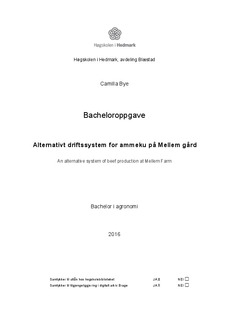Alternativt driftssystem for ammeku på Mellem gård
Bachelor thesis

Åpne
Permanent lenke
http://hdl.handle.net/11250/2394372Utgivelsesdato
2016Metadata
Vis full innførselSamlinger
Sammendrag
Behovet for storfekjøtt i Norge blir stadig større når melkekutallet går ned i takt med økt
avdrått. For å kompensere for dette tapet og redusere mengde importert kjøtt, er det beregnet
at det trengs en stor økning i antall ammeku og ammekuprodusenter de kommende årene. På
samme tid finnes det store ressurser i ubrukte utmarksarealer i Norge, og forbrukeren får et
stadig større fokus på renhet, sporbarhet og dyrevelferd. Å imøtekomme alle kravene og
samtidig produsere mat på norske ressurser er ikke alltid den mest økonomiske utveien, men
disse faktorene kan også åpne for muligheter til å hente ut en merpris i eksklusiv og lokalt
produsert mat. Kan et ekstensivt driftssystem være like lønnsomt som et intensivt, og
forvaltes ressursene på riktig måte? Denne oppgaven har som formål å sammenligne to
alternative driftssystem på Mellem Gård, for så å komme frem til hva som er mest gunstig
med bakgrunn i ressurser og økonomi. Et alternativ med et ekstensivt driftssystem med
utmarksbeiter og rasen Aberdeen Angus, sammenlignes med et intensivt driftssystem med
innmarksbeiter og rasen Charolais. I førstnevnte alternativ med et ekstensivt driftssystem, er
det benyttet markedsundersøkelse for å kartlegge lokalbefolkningens ønske om å betale
merpris for ”grassfed” Aberdeen Angus.
Markedsundersøkelsen viste til at av de 42 personene som ble spurt, stilte flertallet seg
positive til å betale en merpris på 185 kr/kg (inkludert moms) for lokalprodusert og grasfôra
Aberdeen Angus. Skaslien Gjestgiveri, en lokal restaurant som benytter seg av mye lokale
råvarer, stilte seg også positive til å servere produktet i restauranten. Ved å summere ønsket
bestillingsmengde, ville det vært mulig å forsvare økte investeringer i kjølerom og kjølebil,
samt økt arbeidsmengde. Alternativet ga med andre ord den høyeste dekningsbidraget,
samtidig som det ga den høyeste ressursutnyttelsen. Det kom også best ut på kalvingsvansker,
noe som er svært viktig for en produsent i oppstartsfasen. Dette ble alternativet som i
oppgaven er fullprosjektert, hvor deler av slaktet tilbakeleveres for privat salg.
Det er allikevel mange faktorer det må tas hensyn til. Et intensivt system vil trolig kunne gi
bedre avkastning med lavere arbeidsmengde, men et ekstensivt system hvor en må yte noe
mer arbeid for å ha samme avkastning, vil kunne bidra til både merkevarebygging og til noe
positivt for nærmiljøet. Hvordan framtidsutsiktene er for en lokal mat, er vanskelig å si, men
en avtale med Nortura vil øke stabiliteten i produksjonen. The need of beef production in Norway is getting larger as the number of milking cows
decreases with increased milk yield. To compensate for this loss and to avoid a big quantity of
imported meat, the beef cattle number needs to increase the following years. At the same
time, the country has big resources in uncultivated pasture, and the consumer is focusing on
clean and healthy food, as well as animal welfare. To meet all these needs and at the same
time produce food on Norwegian resources is not always the most economical way. But these
factors can also be used to get a premium price on locally produced and grassfed food. Can
an extensive production system be as profitable as an intensive system, and is the resources
managed in a proper way? In this assignment, we will look at and compare two alternative
production systems at Mellem Farm, to figure out what is the most beneficial on the basis of
economy and resources. An alternative with an extensive system with uncultivated pasture
and the breed Aberdeen Angus will be compared with an intensive system with cultivated
pasture and the breed Charolais. In the first alterative, a market research is used to determine
if the consumer would pay a premium price for locally and grassfed beef from Aberdeen
Angus.
The results from the market research is mostly positive, and the majority would like to pay a
price of 185 NOK/kg for locally produced and grassfed Aberdeen Angus. A place called
Skaslien Gjestigiveri, a local restaurant that uses local food in their menu, was also interested
in the project, and they would like to use the product in their menu. The research showed that
selling beef from Aberdeen Angus could defend the increased prices in storage and
transportation, as well as the increased work hours. In other words, the alternative gave the
highest economical returns, and the farm resources were properly managed. At the same
time, Aberdeen Angus has a low rate of calving difficulties, which is important in the
beginning. This is the alternative that is presented in the result- chapter.
There are still many factors that must be taken into account. An intensive system is likely to
bring higher returns with a lower workload, but an extensive system with a higher workload,
can help branding, at the same time as it brings something positive to the local community.
How the future prospects for local food will look like, is still unsure, but an agreement with
Nortura could increase the output stability.